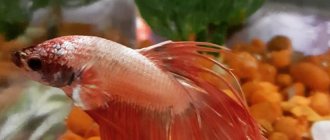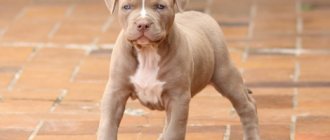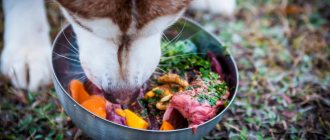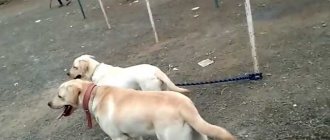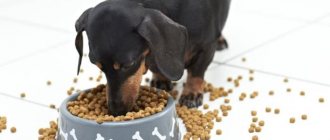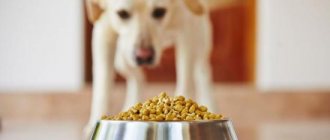Many people dream of having a dog. And most understand perfectly well that along with joy this will also bring certain troubles. First of all, you need to feed your pet properly. And there are many nuances here. When getting a pet, you need to know how many times a day to feed a dog - an adult and a puppy, how much food to give - dry and natural, as well as the peculiarities of feeding representatives of different breeds. It will be useful to understand all these questions in as much detail as possible.
Feeding dogs is no joke
Basic rules for feeding an animal
The main rule that every breeder should remember: a dog is a predator. And it doesn’t matter what breed it belongs to - a mongrel or an elite Chihuahua in the hundredth generation. This means she must eat meat, a source of protein.
The main thing is that the meat is not too fatty - otherwise the dog will gain excess weight. Any poultry, as well as beef and rabbit, can be a good choice.
To make the diet more balanced, you can feed fish once a week. It is advisable to give preference to sea fish - it is cleaned of bones and boiled until tender. Under no circumstances should you give it raw - there is a high risk of infection with parasites.
In addition, several times a week, instead of meat, you should feed offal - best of all, kidneys, heart and liver. They are not only cheaper, but also contain various microelements. The offal is cut into small pieces and boiled until tender.
Important ! Soy, although rich in proteins, is poorly digestible by dogs. In addition, it impairs the absorption of certain microelements, which can lead to serious illnesses.
But the matter is not limited to proteins alone. The diet should include porridge - millet, buckwheat, wheat and oatmeal are considered the best choices.
We must not forget about foods such as vegetables. Experts recommend including carrots, pumpkin and zucchini in your diet - they are easily digestible, not too high in calories and contain a large amount of vitamins. They should be grated and added to porridge with meat.
Feeding regimen - rules of what it should be
The next question is the feeding regimen. It must be tough.
It is necessary to determine how many times a day you need to feed your dog - it depends on the age. After this, choose the optimal time and give food exactly according to the established schedule.
Such stability has a positive effect on the dog’s well-being and mood. It is highly undesirable to be behind schedule - only in force majeure situations.
Proper feeding of puppies
Babies will require a special feeding regimen. As the puppy grows, this regime undergoes changes, because puppies grow 12 times faster than human children. During the first weeks, newborns are fed mother's milk, which contains three times more fat and is richer in protein than cow's milk.
After the 4th week, puppies begin to feed dry food granules soaked in water. Two-month-old puppies are weaned from dog milk and fed 5-6 times a day with solid food at intervals of 3-4 hours. Puppies 3-4 months old feed 4 times - in the morning, in the evening and twice in the afternoon. Until 6 months, one of the feedings is gradually removed.
Photo: https://kotsdog.ru/wa-data/public/shop/img/puppy_3.jpg
Up to 10 months, food is given 3 times, then transferred to an adult diet twice a day. The night break between feedings is minimal while the puppy remains small. When a 2-month-old baby is taken away from his mother, the last feeding occurs around 10 p.m., and the first at 6 a.m. In general, as puppies grow older, meals become less frequent.
Calculation of puppy diet
Usually puppies themselves begin to ignore one of the feedings. But sometimes they are not ready to cancel and ask for more. At the age of 1 year, the puppy is considered an adult and should begin to eat like an adult. A diet consisting of natural products is calculated according to the following rules:
- Up to six months – up to 7 percent of the animal’s weight.
- Half of the diet consists of meat products, the rest is dairy, cereals, and vegetables.
That is, a puppy up to 10 kg should be given 350 g of meat products and the same amount of additional ones. If your pet begins to skip feedings, the next time you cannot increase the portion to avoid overfeeding. For large breeds, the daily intake is divided into small portions, otherwise too rapid weight gain will follow, which will lead to problems with the musculoskeletal system.
Nutrition during pregnancy
The expectant mother is fed more generously, increasing portion sizes, but maintaining the time schedule. No dietary changes are required until 3 weeks of pregnancy. But from the 4th day, 15 percent of the previous daily norm is added, and the additional volume should consist of animal proteins. The feeding frequency can be up to 5 times a day.
When puppies are growing rapidly in the womb, pregnant bitches also need vitamin supplements. Before childbirth, the increase in diet can be up to half the daily requirement. But you should not overfeed, so as not to provoke obesity and the appearance of too large puppies. Usually a couple of days before the puppies arrive, the dog may refuse to eat. There is no need to force feed; your appetite will return on its own after childbirth.
Appetite of a healthy dog
All healthy pets love to eat. The food disappears from the bowl instantly, but satiety comes slowly. It can be considered normal when a dog quickly finishes the portion offered to it, licks the bowl and, looking slightly offended at the owner, returns to its place.
Leaving food in the bowl and not giving extra treats between meals is a signal that portions can be reduced. A hungry animal behaves restlessly, rattles empty bowls at night, anxiously sniffs the feeding area, begs for food, looking into the owner’s eyes, the portion is clearly insufficient for it and requires an increase.
Basic feeding rules
Enough aphids are feeding on the dog, determine by the ribs when it sits. They should be clearly palpable, but not stick out or hide under a solid layer of fat. When raising a puppy, attention is also paid to feeding. It should not happen at the same time as family dinners.
If the owner wants to remain an authority and leader for the dog. He must not forget that the leaders eat first. Throwing tidbits from the common table is unacceptable. Accustomed to being fed during family feasts, the dog can later take food from people itself, snatching it from their hands and taking treats from children.
Photo: https://www.blog.zootovary.ua/wp-content/uploads/2019/03/golden-retriever-puppy-2706672_960_720.jpg
A dog's instinct is often to protect its food. The pet may growl while feeding and will not allow anyone near its bowls. This is another reason to give him food after people eat. And keep children away from the dog while feeding. By following these rules, you can raise a well-mannered friend who will always bring joy.
How many times a day should you feed a puppy: features of different breeds
The basis of the diet is meat.
Usually, up to two months, the puppy eats mother's milk - additional complementary foods can be gradually introduced into the diet, but this is only an addition to the main dish. From two months, the number of feedings should be four in sixteen hours. Accordingly, the portions are small.
Gradually the number of meals is reduced. For example, if the reader is interested in how many times to feed a puppy at 3 months, then three meals is quite enough. By the age of six months, the number of feedings should be reduced to two - physiologically, the puppy has almost turned into an adult dog. Therefore, care must be appropriate.
By the way, it is worth remembering that small and medium-sized dogs mature faster than representatives of large breeds. Therefore, if we are talking about a Newfoundland, mastiff or Caucasian Shepherd, then feeding three times a day should not last up to 6 months, but up to 8-9.
For reference! Dog milk contains almost three times more protein and fat than cow's milk.
Meal time
It is best if the puppy receives food immediately after a walk outside, working up an appetite. In fact, the timing of feeding is not too important here - the main thing is that the food is always given at the same time. Lack of stability may well give rise to stress in a dog and various diseases associated with it, not to mention stomach diseases.
- The first full feeding should be carried out immediately after waking up - at 7-9 hours.
- The last one is 2-3 hours before going to bed, that is, at 6-8 pm.
- It is advisable to distribute the remaining meals (for puppies) evenly throughout the day.
Diet, what you need to know
Building a diet and walking routine begins 1–2 weeks after the dog moves to a new home. There are a number of advantages to creating a specific regime:
- It’s easier to create a complete diet and make sure that the dog gets all the necessary products.
- You know exactly when your pet needs to be taken outside, which prevents “unpleasant surprises” from appearing in your home.
- The dog will not “bite”, which has a positive effect on metabolism.
- The most common cause of poisoning is picking up lost food from the ground. A dog that eats according to a schedule does not feel the desire to eat everything; it knows exactly when it will be fed.
- Diet and exercise regimen reduces the risks of obesity and metabolic disorders.
- If you keep your dog on a chain, regular feeding makes it easier to keep the kennel and area clean.
Feeding dogs depending on breed characteristics
Even a novice breeder understands that the amount of food given to a dog depends not only on age, but also on the breed. It would be foolish to think that dogs like a Newfoundland, German Shepherd or Labrador will eat the same amount as a Spitz or Toy Terrier.
Feeding standards for wet food
It is very correct to follow the dosage. If your dog gets too much food and spends most of his time indoors, this will most likely lead to canine obesity and a serious decrease in life expectancy. On the other hand, with a lack of food and constant physical activity, the dog will become exhausted, and the puppy will not be able to develop normally.
So, it will be useful to know how much food to give your dog per day - the table will help you navigate and choose the appropriate option:
| Dog size | Amount of feed in grams |
| Miniature (from 2 to 5 kg) | 300-400 |
| Small (6 to 10 kg) | 400-700 |
| Medium (from 12 to 24 kg) | 800-1300 |
| Large (from 26 to 40 kg) | 1400-2000 |
| Very large (over 45 kg) | 2050-6000 |
Of course, these data are for adult dogs - that is, one year of age and older. So, knowing its weight, you can easily select the required amount of food for any dog - Yorkie, Husky and other breeds. There probably won't be any problems here.
How to calculate the amount of natural food
It’s a little more complicated if you need to calculate the daily amount of natural food. Usually, experts simply recommend taking the following proportion - about 60-70 grams of food per kilogram of dog weight. In other words, a dog weighing 5 kg per day should receive 300-350 grams of food, if it weighs 10 kg - already 600-700 grams, but if it weighs 30 kg, then from 1800 to 2100 grams.
On a note ! Natural food should be at room temperature - then it is best absorbed.
But these are very average indicators. It is worth considering where the dog will live - in an apartment, on a cozy sofa and rarely going outside or in a kennel, where it is necessary to withstand frost. Of course, this determines how much the dog should eat in order to feel good - based on this, the portion can be slightly increased or decreased.
Finally, the composition of the feed should be taken into account. If it contains more meat, the portion can be reduced. Conversely, if a third of the food consists of low-calorie vegetables, it should be increased.
How much dry food does a dog need per meal?
A good appetite is a sign of health.
But this option is considered the simplest. The packaging almost always contains the necessary information. That is, to find out how much food a dog needs per day, just read the table and find the weight corresponding to the weight of the pet. After this, all that remains is to measure the appropriate amount of feed on the scale.
Many experienced breeders make a special measuring container with a mark that makes it easy to measure the right amount of food without using a scale each time. This makes feeding the dog much easier.
How to tell if your dog has enough food
All this is, of course, good. But every dog owner wants to know whether his pet has enough food or is he walking around half-starved?
The answer to the question will be given by the dog's behavior. It is necessary to pay attention to what actions she performs after a meal. For example, if she often leaves food in the bowl and comes back to finish it several hours later, then an excessive amount of food is given - the diet needs to be reduced.
And vice versa, if, after eating the prescribed portion, the dog does not leave the bowl, carefully licks it, and when he sees the food, begins to squeak, fawn and beg for more, then next time it is advisable to give more food - the dog clearly does not finish eating.
What to feed your dog
Food for dogs should be fresh and as healthy as possible.
Types of dog food:
- natural food;
- special dry food.
Proper consumption of natural food depends on the weight of the animal. Before the age of six months, the amount of food in the diet should not exceed 7% of body weight, after this age it decreases to 3.5%. As natural food, you can give meat, cottage cheese, kefir, cereals, and vegetables.
It is not difficult to determine the amount of dry food per day, because the packaging should indicate the consumption rate for the dog according to age. When introducing this type of food into your diet, you should adhere to the amount indicated on the label, and over time it will be possible to adjust it by reducing or increasing the portion. And also how much food to consume depends on its type; more concentrated food needs less, and regular food needs a little more.
Number of feedings depending on the age of the dog
Nutrition for puppies is especially important
Most adult dogs need to be fed twice a day. Especially large and slow ones can be given food only once a day.
But puppies should have several main meals - preferably morning and evening, as well as several snacks. The latter should be evenly distributed so that the pet never feels hungry - for juveniles this is fraught with serious problems in the future.
Feeding mode
In my article about natural feeding of dogs, I already wrote what feeding regimen I recommend following. But I see that this needs more attention. So.
An adult healthy dog eats 1-2 times a day. It is most physiological to feed your dog after a walk and/or after exercise. Why? 1. Firstly, walking, working and training in the city are the equivalent of hunting for a domestic dog. I hunted and ate. 2. Secondly, dogs, like all predators, tend to eat from the belly and digest food at rest. Active movements on a full stomach can lead to very sad consequences, such as intestinal volvulus. 3. Thirdly, by taking a well-fed dog for a walk, you are deprived of such a wonderful way of influencing it as a treat. This is especially important when it comes to a dog undergoing training. Feeding times are usually set approximately the same in the family, and this is reasonable. But this does not mean that the time cannot shift depending on an unscheduled walk, training or competition. I feed the dogs 2 times a day, morning and evening, after a walk. If we have a race in the morning, then I feed him after the race, usually at about 4 pm, and then in the evening I don’t feed him anymore.
The bowl of food is placed for 15 minutes. In fact, it's even simpler. The bowl remains in place while the dog eats from it. If the dog has lost interest in the food in the bowl, he immediately removes it. All. The same is true if you gave the dog meat in a large piece, possibly with cartilage. As long as the dog chews and gnaws on it, everything is fine. Lost interest, got up and left - we clean it up. Why? 1. The dog is a predator. For her, it is most physiological to eat a lot at one time, rather than bite into pieces throughout the day. To properly digest meat, a dog's stomach must produce a lot of acid, and all the dog's digestive juices must be very concentrated. Digestive juices are an “expensive commodity.” Their synthesis requires time (and energy, and a lot of building chemical material). If a dog snacks constantly throughout the day, digestive juices must flow into the stomach and intestines constantly. They simply do not have time to synthesize. And, by the way, the amount of juices released never corresponds exactly to the amount of food eaten; usually more juices are released. Without being used, they are partially reabsorbed, but partially come out with feces - and now they are lost forever. Thus, a deficiency of digestive juices – acids and enzymes – appears and increases. By the way, this may cause the dog to pick up carrion and other people’s excrement on the street (they are easier to digest). And at the same time this leads to digestive disorders. How severe they will be depends on the initial condition of the dog. 2. A dog is a pack animal, and in its world there is a clear hierarchy system. And it will be better for everyone if the owner in this system takes the top line. This is the main thing that ensures the dog's obedience and safety. And the easiest way to become a leader for your dog is to take control of his food. Do you understand? You provide the food. Good, tasty and healthy food, in sufficient quantities. The dog doesn't want her? Great, you take the food. In the interim, the dog receives food only as part of the reward for work. By the way, if you are training a dog, always keep in mind that treats are part of its daily diet, and the portion of food should be reduced by the portion of the treat eaten! And the dog, of course, should not receive food from your table. She has absolutely nothing to do at your table. 3. Sometimes during the training process there are situations when the dog needs to be punished for unacceptable behavior. This happens especially often with teenagers, especially often with teenagers of “difficult” breeds, which include Basenjis. One of the most effective punishments is to ignore the dog. But ignoring will only work when it is really complete. Those. You don't notice the dog at all. Accordingly, do not feed. Usually it works like this: after a terrible offense (ran away, didn’t come for 2 hours), you don’t talk to the dog for half a day or a day, and the dog skips feeding. If you always have food freely available, then you lose an excellent lever for controlling the behavior of an overbearing teenager. It turns out like in a poem by an author unknown to me:
“You go out for a walk. Dogs of all colors and sizes are running past - choose the biggest one. Approach the giant boldly and grab the greyhound in the belly - Let everyone in the area know that you are not a mattress either. It doesn’t matter that afterward “mom” will drag you by the neck, let him stomp his feet and flog him a little, anyway, dinner will certainly be on schedule, and, satisfied, you, having eaten, will go to bed until the morning.”
And I’ll immediately answer a frequently asked question: what should you do if your dog is always ASKING TO EAT? We agreed that we were talking about a domestic dog that was well fed, healthy and in good physical shape. This is not a lactating bitch who is constantly being suckled by puppies. And not a poor, emaciated dog brought from the street. And not a dog that is recovering from a serious illness. Therefore, do nothing. Feed as usual, move away from your table and be happy that everything is fine with your dog. Because a healthy dog always wants to eat , and more.
Let me summarize. Dog food is NEVER freely available to dogs. The dog should receive high-quality, balanced food that it loves and that is good for its health. 1-2 times a day, after a walk and/or exercise, a bowl of food is given to the dog. If the dog doesn’t eat something, that’s his choice. You treat him with respect, but you put the bowl away until the next feeding.
PS, by the way, you can conclude that your dog does not like, say, rice. Or green beans. There are even dogs that don't like tripe. And my Ellie doesn't like raw eggs. They have a right. Consider your dog's taste preferences, but within reasonable limits.
Lyudmila Amarantova citidog.online
Feeding during illness and recovery
If a dog doesn’t feel well, then it probably won’t have an appetite—there’s clearly no point in worrying about this. All the body's resources are devoted to fighting the disease, so the dog simply does not want to eat.
But during recovery from illness, the dog will probably have an increased appetite. You can give him more food. Some dog experts also recommend increasing the amount of fat in the diet. Then the pet, by eating a little food, will receive a large amount of calories, which will help it recover faster and return to its normal lifestyle.
Remember ! If the dog is fed dry food, then during recovery it should be soaked in water so that it turns into a kind of porridge, which is much easier to eat.
In addition, if the dog’s diet consists of natural food, then the porridge should be made more liquid - increase the amount of broth. Such food is easier to eat and digest, so a slight change in the usual food will clearly benefit your pet.
Dog diet
The owner must create an individual diet for feeding the pet. Apart from him, no one can know the amount and composition of food or dry hypoallergenic food that his animal specifically requires.
Dogs do not feel full, so you should not give the animal the right to decide how much food to eat per day.
Freedom of action can lead to overeating and obesity. Often after a hearty meal, the pet watches the owner’s meal with pitiful eyes, begging for tidbits. You can't give in to persuasion. When the pet realizes that nothing is going to happen for him, he will go about his business.
You need to react a little differently to the begging situation if the dog is not just begging for tasty morsels, but is looking into the bowl all day long. The owner should think about the insufficiency of the daily portion and increase its volume. If this measure does not help and the pet again requires supplements without measure, you need to contact a veterinarian for a health check - this may be a manifestation of worms. Photos of similar parasites were published earlier.
The daily volume of natural food should be approximately equal to three to four percent of the animal’s weight. When feeding with industrial feed, pay attention to the information on the pack - the daily food requirement is always indicated there. However, the indicators are generalized; depending on activity and other characteristics, you can increase or decrease the portion.
Malnutrition and overfeeding cause harm to the animal’s body, so the owner must find a balance in feeding the dog.
Nutrition during pregnancy
The dog needs special attention during pregnancy. After all, now she provides calories and necessary substances not only for herself, but also for several puppies that are forming inside. If there is not enough food and nutrients, this can undermine the pet’s health and also affect the development of the puppies.
- So, in the first month, the diet can remain familiar - the load on the body is minimal.
- Already in the fifth week, the portion needs to be increased - by about 10-12%.
- This should be repeated every week until delivery. Usually during that time the standard diet increases by almost one and a half times.
The bitch will probably not be able to eat this amount of food in two meals, so in the sixth week of pregnancy it is advisable to switch to three meals a day, and subsequently to four meals a day. This will have a positive impact on the well-being of the expectant mother and the health of the offspring.
Lactating bitch needs increased rations
After giving birth, you should also stick to an already formed diet - the bitch gives away a lot of useful substances with milk. But by the end of the first month, the puppies gradually switch to complementary foods. At the same time, you need to start reducing the dog’s diet. Then, by the time the offspring can feed on their own (usually by two months), the amount of food the bitch eats will be reduced to standard.
After studying the article, every dog owner will be able to choose the appropriate diet, regimen and method of nutrition for their pet. This means that the dog will live a long and happy life to the delight of everyone around him.
